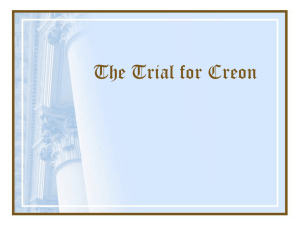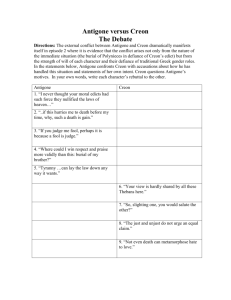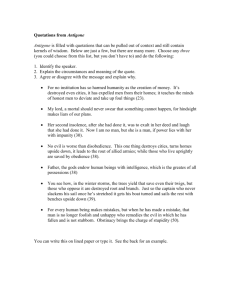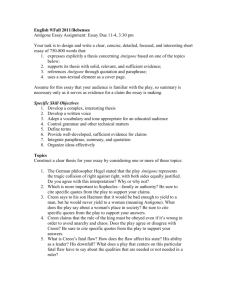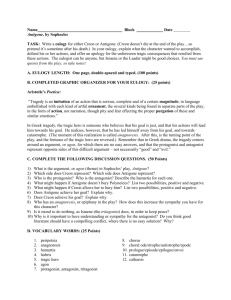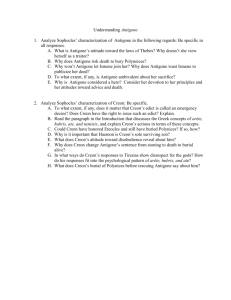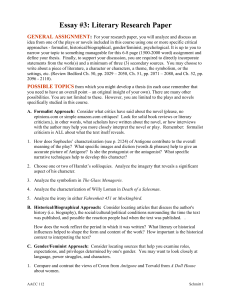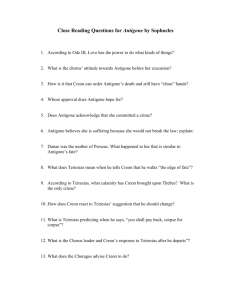GUIDANCE NOTES ON `ANTIGONE` ESSAY
advertisement
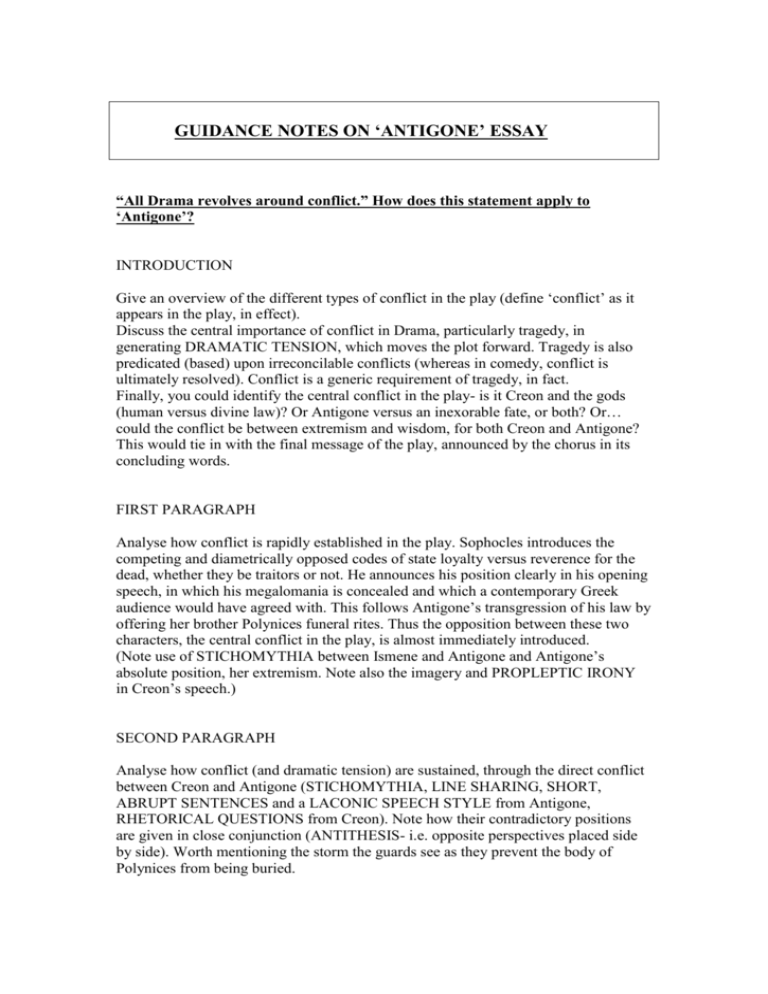
GUIDANCE NOTES ON ‘ANTIGONE’ ESSAY “All Drama revolves around conflict.” How does this statement apply to ‘Antigone’? INTRODUCTION Give an overview of the different types of conflict in the play (define ‘conflict’ as it appears in the play, in effect). Discuss the central importance of conflict in Drama, particularly tragedy, in generating DRAMATIC TENSION, which moves the plot forward. Tragedy is also predicated (based) upon irreconcilable conflicts (whereas in comedy, conflict is ultimately resolved). Conflict is a generic requirement of tragedy, in fact. Finally, you could identify the central conflict in the play- is it Creon and the gods (human versus divine law)? Or Antigone versus an inexorable fate, or both? Or… could the conflict be between extremism and wisdom, for both Creon and Antigone? This would tie in with the final message of the play, announced by the chorus in its concluding words. FIRST PARAGRAPH Analyse how conflict is rapidly established in the play. Sophocles introduces the competing and diametrically opposed codes of state loyalty versus reverence for the dead, whether they be traitors or not. He announces his position clearly in his opening speech, in which his megalomania is concealed and which a contemporary Greek audience would have agreed with. This follows Antigone’s transgression of his law by offering her brother Polynices funeral rites. Thus the opposition between these two characters, the central conflict in the play, is almost immediately introduced. (Note use of STICHOMYTHIA between Ismene and Antigone and Antigone’s absolute position, her extremism. Note also the imagery and PROPLEPTIC IRONY in Creon’s speech.) SECOND PARAGRAPH Analyse how conflict (and dramatic tension) are sustained, through the direct conflict between Creon and Antigone (STICHOMYTHIA, LINE SHARING, SHORT, ABRUPT SENTENCES and a LACONIC SPEECH STYLE from Antigone, RHETORICAL QUESTIONS from Creon). Note how their contradictory positions are given in close conjunction (ANTITHESIS- i.e. opposite perspectives placed side by side). Worth mentioning the storm the guards see as they prevent the body of Polynices from being buried. THIRD PARAGRAPH Analyse the conflicts between Creon and the gods and Antigone and her implacable fate. Note Creon’s HUBRIS, the BLASPHEMOUS imagery he uses (e.g. the eagle carrying its carrion to the very altar of Zeus), his encounters with Ismene, Haemon and Tiresias and the SADISM he ememplifies when arguing with Haemon. Note the role of the CHORUS here in generating expectation of Creon’s downfall, through OMENS. Note Haemon’s mention of the city’s sympathy with Antigone and how Creon reveals his megalomania and tyranny. FOURTH PARAGRAPH Antigone versus her fate. Look closely at her final valedictory speech, in which she defines herself as a tragic heroine and reveals her true motivation. Note her use of MYTHIC ALLUSIONS and PARALLELS, e.g. to Persephone and Niobe, to amplify her fate and status. FIFTH PARAGRAPH Analyse Creon’s punishment, an expression of THEODICY, or divine justice. Note what happens and how the destruction of his family links back to his words in his initial speech, about the wise man governing his family well. Note what he learns through his suffering also. CONCLUSION Appraise how important the concept of conflict is to Antigone and to all tragic drama. Perhaps conclude by identifying the most important element of conflict in the play (the one most relevant to the play’s identity as a tragedy). I DON’T WANT THIS 15 TIMES! Don’t JUST use these ideas in this exact order. I will reward ORIGINAL IDEAS and you should aim to take risks. Do remember EMBEDDED QUOTATION too. Good luck! ; )
